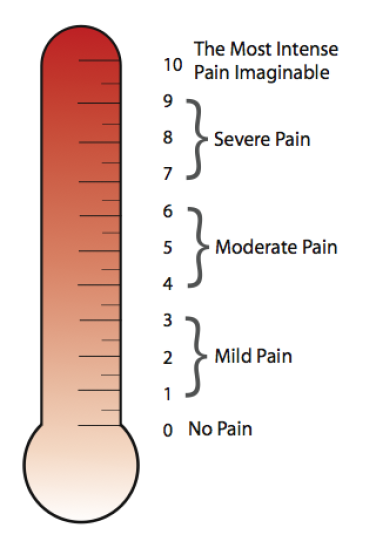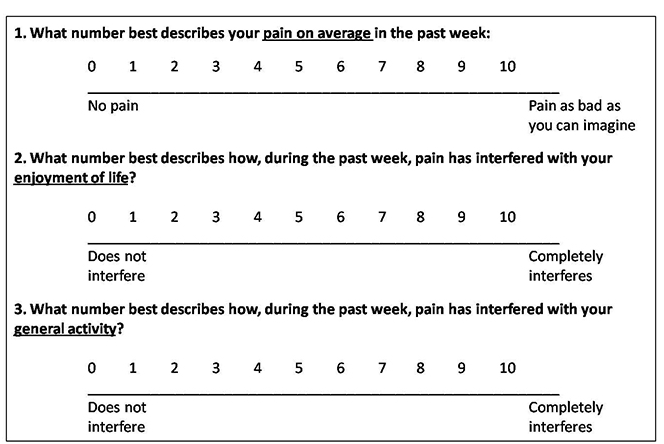
FAST FACTS: Selected Pain Assessment Tools
The first step in assuring quality pain care is appropriate pain assessment. While pain is highly subjective, if able to self-report, an individual is the best source of accurate information about their pain. It is important to gather information about several aspects of the pain experience including pain severity/intensity, location, duration, aggravating and alleviating factors that impact pain, and the impact of pain on activity. Assessing pain in older adults can be difficult and a caregiver can be helpful by gathering information to share with the healthcare provider. You can use a pain assessment tool in combination with a Pain Diary to collect information. By sharing this information with your loved one’s healthcare team, you will help them have a clear understanding of your loved one’s pain over a given period and provide critical information for the development and ongoing review of a pain treatment plan.
There are several types of pain assessment tools that can be used to collect this information.

Iowa Pain Thermometer-Revised or Verbal Descriptor Scale (VDS)
- PURPOSE: Used to rate pain intensity in people who are able to self-report. Research indicates this is the best choice for most older adults.
- WHO CAN USE: Goor for use with any patient, including those with moderate to severe cognitive impairment who have difficulty communiticating verbally. Have the patient point to the word on the thermometer that best shows how bad or severe their pain is now.
- HOW TO USE: Select the words on the thermometer to show how bad or severe pain is right now. Comparing the words chosen after each use to the words chosen at previous time points helps to determine if pain has increased or decreased.
Numeric Rating Scale

- PURPOSE: To assess pain intensity in people who are able to self-report pain.
- WHO CAN USE: Good for use with individuals who can point or state the number that reflects current pain level on a 0-10 scale (0=No pain/10=Worst possible pain)
- HOW TO USE: Point to or state the number that best shows how bad pain is NOW. As is done with the VDS, comparing the number chosen after each use to the number chosen at previous time points helps to determine if pain has increased or decreased.
FACES Pain Scale Revised (PRS-R)
- PURPOSE: Pain intensity rating scale useful for all older adults, including those with mild to moderate cognitive impairment. Some older adults will find this tool easy to use and may prefer it over the Numerical Rating Scale. This scale requires either verbal ability or the ability to point to the image on the scale that most closely represents their pain.
- WHO CAN USE: Good for use with people who can point to the face that best describes their pain at the moment.
- HOW TO USE: Say to the older adult something like - "I'd like you to tell me about much pain you are having. I'm going to show you pictures of some faces. These faces show how much pain or discomfort someone may be feeling. The face (#0) on the left shows no pain. Each face shows more and more pain up to the last face (#10) on the right that shows the worst pain possible. Point to the face that shows how bad your pain is right NOW.”
- Note to caregiver: Do not look at your loved one’s facial expression and pick a face. Let them choose.

References:
Herr, K. Booker, S.Q., & Bartoszezyk, D. (2018). Gerontology pain management. In M.L. Czarncki and H.N (eds). Core curriculum for pain management nursing (3rd ed, pp.424-437). St. Louis, MO: Elsevier Horgas, A.L. (2017). Pain assessment in older adults. Nursing Clinics of North America, 52(3), 375-385. Brooker, S.Q. & Herr, K.A. (2016). Assessment and measurement of pain in adults later in life. In Clinical Geriatric Medicine, 32(4), 677-692c. Ngu, S.S.C., Tan, M.O. Subramanian, P., Rahman, R.A., Kamaruzzamn, S., Chink, A.V., Poi, P.J.H. (2015). Pain assessment using self-reported, nurse reported, and observational pain assessment tools among older individuals with cognitive impairment, Pain Management Nursing, 16(40, 595-601.
PEG Scale Assessing Pain Intensity and Interference (Pain, Enjoyment, General Activity)
- PURPOSE: Pain intensity rating scale that requires either verbal ability or ability to point to the number that most closely represents their pain.
- WHO CAN USE: To assess pain intensity in persons who are able to self-report and use a numeric rating scale.
- HOW TO USE: Ask the three questions on the pain assessment tool then compute the PEG score as outlined below.
- Computing the PEG Score: Add the three questions, then divide by three to get an average score.
- Using the PEG Score: The score is best used to track changes in pain over time. Starting pain therapy (medication and/or nondrug therapies) should result in the score decreasing over time.

Reference: Krebs, E.E., Lorenz, K.A., Bair, M.J., Damush, T.M., Wu, J., Sutherland, J.M., Asch S, Kroenke, K. (2009). Development and Initial Validation of the PEG, a Three-item Scale Assessing Pain Intensity and Interference. Journal of General Internal Medicine, 24(6), 733-738.
Final Comments on Pain Assessment Tools
- Select a pain assessment tool appropriate for your loved one and use it each time you assess their pain.
- Document pain information using a Pain Diary and review with their healthcare provider on a regular basis.
Revised January 2022
